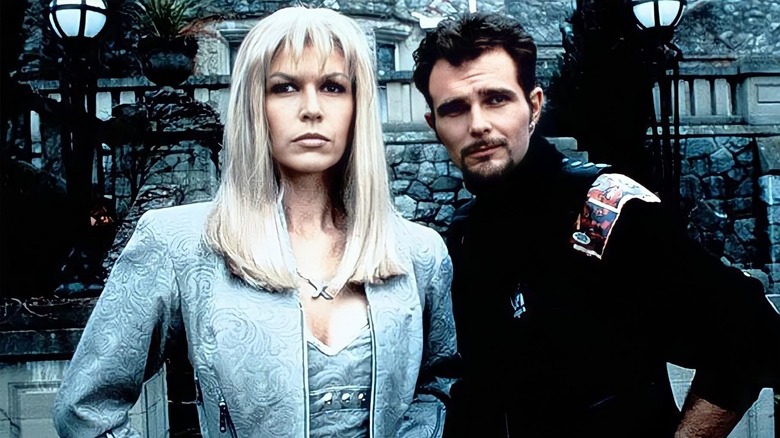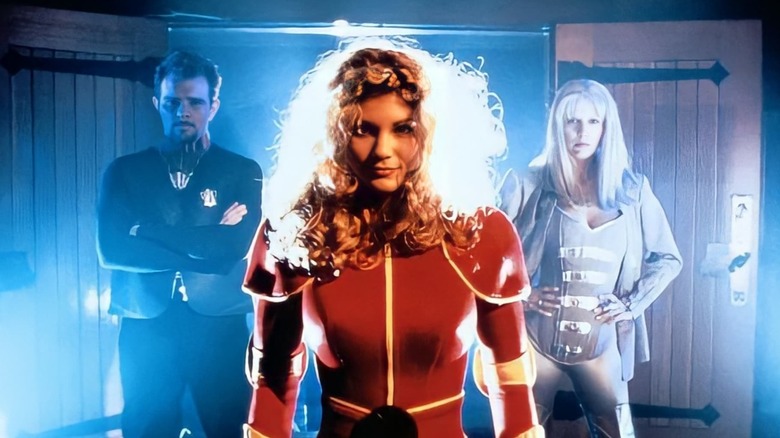Marvel's First Live-Action X-Men Attempt Went Horribly Wrong
In November of 1994, Marvel Comics launched an X-Men title to feature an almost all-brand-new crop of teen characters called, collectively, Generation X (who were, weirdly, not members of Generation X like Crow T. Robot). The team consisted of the established X-Woman Jubilee, joined by striking superpowered high-schoolers like Chamber, Husk, Skin, Mondo, M, and Synch. The team was overseen by Banshee and the White Queen, and their adventures aimed to be hipper and edgier — in that MTV sort of way — than those of their adult counterparts.
"Generation X" was a modest hit with comics readers, but not enough to stick around indefinitely. The series ended after three years and 75 issues. The characters, however, were perfect fodder for a "young 'n' hip" version of the X-Men, a fact that TV producers at Fox latched onto. In 1996, Fox executive producer Eric Blakeney, one of the writers of "21 Jump Street," felt he could take his previous show's "teens as undercover law enforcers" shtick, and apply superpowers to it. Using "Generation X" as his jumping-off point, Blakeney penned the pilot for an all-new live-action TV series, set in the near future, and affecting a kind of cyberpunk attitude. It was the first live-action version X-Men movie or TV show in Marvel history.
It also, some readers may know, wasn't well-received in the least. The pilot episode of "Generation X," which aired on February 20, 1996, was a clunky, over-stylized affair, more reminiscent of "Hackers" than "X-Men." Although the pilot cost $4 million, a lot of the visual effects looked odd and artificial. It was filmed with swirling, over-colorful, hyper-edited MTV techniques that felt instantly dated. There are a lot of green gels, and the story was really, really weird.
X-Men fans stayed away from "Generation X" in droves, and it quickly fell into obscurity. Years later, when the YouTube generation found it, however, "Generation X" was roundly mocked for its silliness, and many consider it to be one of the worst X-Men film projects ever produced.
The Generation X pilot did not go to series
Needless to say, the pilot didn't go to series, and only aired as a TV movie.
Jack Sholder, one of the masters behind "Tales from the Crypt," was hired to direct, and he brought the requisite amount of verve to the project. Finola Hughes played the White Queen, Jeremy Ratchford played Banshee, and Heather McComb played Jubilee. Straight from the "Generation X" comics, Amarilis played M, Bumper Robinson played Mondo, and Augustin Rodriguez played Skin. Sadly, other Generation X characters — like Husk and Chamber — couldn't be realized in live-action without a sizable SFX budget, so several of them needed to be cut. New, more manageable characters named Buff (Suzanne Davis) and Refrax (Randall Slavin) were invented for the series in their place.
Jubilee, like in the comics, could manifest fireworks-like explosions. In the comics, Jubilee is described as being of Chinese descent, but was played by a white actress on screen. Mondo could touch hard objects and absorb their density. Skin had skin that could stretch a great distance, and M was "perfect" (that was her superpower). Refrax had eye lasers, but was also developing x-ray vision, a power that greatly distressed Buff, who was self-conscious about her bulky musculature and hates that Refrax, like a creep, keeps threatening to spy on her through walls (to his credit, he never actually does).
The highlight of "Generation X" was the amazing Matt Frewer (Max Headroom himself!) as the villain, Russell Tresh. The makers of "Generation X" were clearly inspired by the 1990s popularity of Jim Carrey (specifically as he appeared in "Batman Forever"), and seemingly instructed Frewer to go full ham, overacting and cackling to the best of his abilities. Frewer was certainly game, gnashing and writhing with all his might. Frewer provided at least 80% of the entire pilot's energy.
What is Generation X about?
The plot of "Generation X" is nonsensical. It starts with the usual X-Men premise at least. In the near future, teens begin mutating spontaneously, developing unique and sometimes destructive superpowers. There is a prejudice against mutants, and certain privileged few are protected inside the walls of the Charles Xavier Academy, a secret boarding school for mutants in upstate New York. The main characters all move into the X Mansion, and instantly begin hating each other. In this version of the X-Men universe, however, all mutants are mildly psychic.
Russell Tresh, meanwhile, works as a dream science expert for a multinational advertising firm. He has figured out a way to embed subliminal ad messages into media, forcing teens to over-consume. He also has invented a dream machine (!) that allows him to invade people's dreams, "Inception" style, and interact "in person." Mutants, he finds, can see through his subliminal suggestions, and might let him move his consciousness into the dream dimension. Tresh develops a plot to extract mutant brain fluid (!) and make himself a super psychic. Oh yes, and he used to date the White Queen.
In between kidnappings, weird dream scenes, and really horrid exposition dumps explaining superpowers, the central teen characters snipe at each other, sneak out to ice cream socials, and use their powers in public. There's no reason "Generation X" shouldn't have worked, and the cast is mostly fine. It may have failed because the story was too complex, and because it didn't resemble the X-Men comics one whit. Most of the classic X-Men characters were left behind, and the versions we knew didn't resemble their counterparts. Once the YouTube crowd got a hold of "Generation X" in the late-2000s, it gained a notorious reputation, and there are no shortage of videos picking apart what's bad about it (most of it) and what's good (mostly Matt Frewer).
"Generation X" was a unique, strange animal. May it live on in our hearts.


